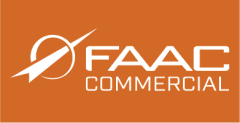FAAC Builds Industry’s First Vertical Screen Array for Transit Driving Simulators New Viewing Concept Expands Instructors’ Capability; Adds Functional Realism
Published
FOR IMMEDIATE RELEASE – Ann Arbor, MI – FAAC’s new vertically optimized screen array is being deployed for the first time after a recent contract award in Ontario. Company engineers have developed a configuration for very large format flat panel monitors, installed vertically to create a ‘sidewalk-to-sky’ viewing angle.
The transit application of this engineering breakthrough is an excellent example of how FAAC’s diverse training
group collaborates with in-house engineers to develop state-of-the-art, advanced features resulting in direct customer benefit.
Development of the large-format viewing angle adheres to FAAC’s stated training values, said Lead Trainer Chuck Deakins. FAAC’s training values were developed to maintain the highest level of professional instruction to new
trainers, ensure smooth transition of the simulator into existing programs, and unlock the power that the simulator can provide to a training curriculum.
“Two of the values addressed here include advanced teaching methodologies and the immediate demonstration of mastery of a specific application,” Deakins said. “An instructor will be able to reinforce fundamental crash avoidance and liability reduction skills, such as scanning and assessing and over-the-shoulder checks, through the increased field of view and new physical boundaries. The large viewing window enables the instructor to watch the student and ensure that he or she is making the proper visual checks when it comes to techniques like servicing a stop or scanning around the bus for hazards.”?
Bus operators, and those who train them, place a premium on maintaining constant awareness of the area immediately surrounding their bus, said Nigel Lindsey-King, FAAC’s Transit Subject Matter Specialist.
“Proper mirror set-up and usage are fundamental skills for maintaining that spatial awareness in relation to fixed and stationary objects, particularly during right- and left-hand turns,” said Lindsey-King. “FAAC’s new screen array enables instructors to drill down on this area of training, and that will lead to safer operators on the street,” he said.
The vertical viewing angle is the latest in a long list of transit simulation training firsts for FAAC, which culminated recently in its flagship simulator MB-2000 being named one of APTA’s Top 100 bus safety innovations. Other firsts
include the use of real mirrors on a simulator, use of an instructor-driven vehicle in a scenario, and first to create a 315-degree field of view.
“The transit industry looks to us to lead the innovation in simulation training methodology and we are proud to meet and exceed their expectations,” said Clayne Woodbury, FAAC’s North American Transit Sales Manager. “Our
dedication to the transit industry enables us to drive the innovation in this space, which ultimately means the best product for the end-user. This is a rapidly changing market space, and while others may eventually catch up to us in one area we are proud to be able to lead the way into new areas.”
For more information about FAAC Incorporated or its municipal bus simulator products, please visit our website faac.wpengine.com or call Mr. Clayne A. Woodbury at 734-761-5836.

